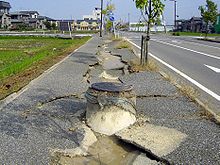
Back Bodemvervloeiing Afrikaans تسيل التربة Arabic Liqüefacció del sòl Catalan Likvefaktion Danish Bodenverflüssigung German Grundlikvigo Esperanto Licuefacción de suelo Spanish روانگرایی خاک Persian Maaperän vettyminen Finnish Liquéfaction du sol French



Soil liquefaction occurs when a cohesionless saturated or partially saturated soil substantially loses strength and stiffness in response to an applied stress such as shaking during an earthquake or other sudden change in stress condition, in which material that is ordinarily a solid behaves like a liquid. In soil mechanics, the term "liquefied" was first used by Allen Hazen[1] in reference to the 1918 failure of the Calaveras Dam in California. He described the mechanism of flow liquefaction of the embankment dam as:
If the pressure of the water in the pores is great enough to carry all the load, it will have the effect of holding the particles apart and of producing a condition that is practically equivalent to that of quicksand... the initial movement of some part of the material might result in accumulating pressure, first on one point, and then on another, successively, as the early points of concentration were liquefied.
The phenomenon is most often observed in saturated, loose (low density or uncompacted), sandy soils. This is because a loose sand has a tendency to compress when a load is applied. Dense sands, by contrast, tend to expand in volume or 'dilate'. If the soil is saturated by water, a condition that often exists when the soil is below the water table or sea level, then water fills the gaps between soil grains ('pore spaces'). In response to soil compressing, the pore water pressure increases and the water attempts to flow out from the soil to zones of low pressure (usually upward towards the ground surface). However, if the loading is rapidly applied and large enough, or is repeated many times (e.g., earthquake shaking, storm wave loading) such that the water does not flow out before the next cycle of load is applied, the water pressures may build to the extent that it exceeds the force (contact stresses) between the grains of soil that keep them in contact. These contacts between grains are the means by which the weight from buildings and overlying soil layers is transferred from the ground surface to layers of soil or rock at greater depths. This loss of soil structure causes it to lose its strength (the ability to transfer shear stress), and it may be observed to flow like a liquid (hence 'liquefaction').
Although the effects of soil liquefaction have been long understood, engineers took more notice after the 1964 Alaska earthquake and 1964 Niigata earthquake. It was a major cause of the destruction produced in San Francisco's Marina District during the 1989 Loma Prieta earthquake, and in the Port of Kobe during the 1995 Great Hanshin earthquake. More recently soil liquefaction was largely responsible for extensive damage to residential properties in the eastern suburbs and satellite townships of Christchurch during the 2010 Canterbury earthquake[2] and more extensively again following the Christchurch earthquakes that followed in early and mid-2011.[3] On 28 September 2018, an earthquake of 7.5 magnitude hit the Central Sulawesi province of Indonesia. Resulting soil liquefaction buried the suburb of Balaroa and Petobo village 3 metres (9.8 ft) deep in mud. The government of Indonesia is considering designating the two neighborhoods of Balaroa and Petobo, that have been totally buried under mud, as mass graves.[4]
The building codes in many countries require engineers to consider the effects of soil liquefaction in the design of new buildings and infrastructure such as bridges, embankment dams and retaining structures.[5][6][7]
- ^ Hazen, A. (1920). "Hydraulic Fill Dams". Transactions of the American Society of Civil Engineers. 83: 1717–1745.
- ^ "Geologists arrive to study liquefaction". One News. 10 September 2010. Archived from the original on 12 October 2012. Retrieved 12 November 2011.
- ^ "Christchurch areas to be abandoned". The New Zealand Herald. NZPA. 7 March 2011. Retrieved 12 November 2011.
- ^ "Indonesia earthquake and tsunami: All the latest updates". www.aljazeera.com. Retrieved 2018-10-30.
- ^ Building Seismic Safety Council (2004). NEHRP recommended provisions for seismic regulations for new buildings and other structures (FEMA 450). Washington D.C.: National Institute of Building Sciences.
- ^ CEN (2004). EN1998-5:2004 Eurocode 8: Design of structures for earthquake resistance, part 5: Foundations, retaining structures and geotechnical aspects. Brussels: European Committee for Standardization.
- ^ International Code Council Inc. (ICC) (2006). International Building Code. Birmingham, Alabama: International Conference of Building Officials, and Southern Building Code Congress International, Inc. p. 679. ISBN 978-1-58001-302-4.